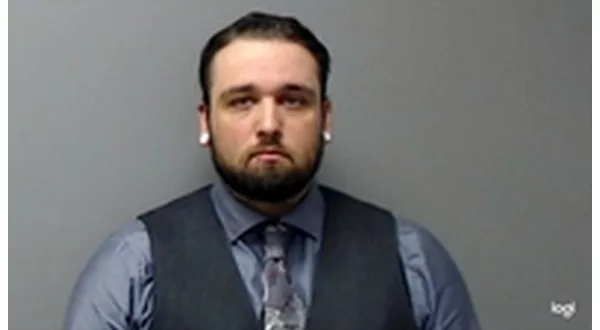
Steven Walski
A Mountain Home man facing 99 counts of possessing child pornography will accept a negotiated plea worked out with the state, according to an announcement made Thursday by one of the attorneys representing 35-year-old Steven Walski.
Walski, who formerly owned a barber shop in downtown Mountain Home, will reappear in Baxter County Circuit Court August 14 to formally accept the plea and be sentenced.
A supplemental hearing had been set for Thursday on a motion filed by the defense to suppress evidence in the case. The plea acceptance was announced by Emily Reed, one of the attorneys representing Walski, before the hearing began.
The original hearing on the motion to suppress was held in mid-July last year.
On February 3, Circuit Judge John Putman filed an order in which he said the court could not decide the major questions at issue in the case based only on arguments made by attorneys at the initial suppression hearing.
The planned hearing Thursday was set to further argue the motion to suppress.
One of the basic issues that the circuit court had been asked to decide is whether the initial detection of the images of child porn alleged to have ended up on Walski’s computer was legal or a violation of his rights.
If the court had granted the motion, it could have meant that evidence in the case would not have been admissible.
The 19-page motion filed by the defense asking for the evidence to be thrown out contends the information in the affidavit used to obtain the initial search warrant in Baxter County was deficient in several areas and, therefore, invalid.
There were several search warrants issued during the investigation that eventually implicated Walski and led to his arrest.
The state asked that the court dismiss the motion to suppress contending the warrants issued during the investigation of the case were valid and that evidence was gathered legally.
Sheridan attorney Jeremy Lowery appeared for Walski in the initial suppression hearing last year. He told the court, because the original search was done by a corporate computer and without a warrant, “there was no human being” on the other side of the tip that eventually led to Walski’s arrest.
Lowery said that meant there was no way for the defense to determine how the information was gathered or to determine if the person gathering the information was reliable.
The state contends the private company that first reported the suspected Child Sexual Abuse Material (CSAM), Synchronoss, uses an automated system set up to recognize suspected child porn, not a single individual.
Synchronoss is a company that offers various services to providers such as Verizon and AT&T.
When suspect material is detected, the company’s automated system reports the finding to the National Center for Missing and Exploited Children (NCMEC).
The state told the court that “a Synchronoss employee does not view the information or images before a cybertip is made — a computer does,” based on a system that utilizes “identifiers” to tag certain material as possible child pornography.
Once the suspect material is sent to NCMEC, it is then viewed for the purpose of establishing that it does contains CSAM and a cybertip is generated and sent to local law enforcement.
When the cybertip in the Walski case was received from NCMEC, a Mountain Home Police Investigator reviewed files using a secure access system and confirmed they met the criteria for CSAM.
In answering the defense’s motion to suppress evidence, the state says Walski, “agreed to the monitoring” of his account when he signed Synchronoss’ terms and conditions.
In signing the agreement, Walski gave The private company permission to check his accounts on its network to ensure he was abiding by those terms and conditions and the company “did not need probable cause to conduct the initial search for Walski’s account.”
INVESTIGATION AND ARREST
Walski was arrested in early November 2021 following an investigation spanning several months.
According to the probable cause affidavit, the investigation was launched after it was determined Walski had violated the company’s terms and conditions by manipulating an image containing Child Sexual Abuse Material (CSAM).
During the investigation it was discovered that several downloads of CSAM were allegedly made by and traced to Walski.
According to investigative reports, a large majority of the images depicted nude young females engaged in sexual contact with adults or who were “sexually posed.”
WHAT OTHER COURTS HAVE SAID
This issue is a relatively new one and courts in the U.S. are grappling with several questions regarding the involvement of electronic tools, such as CSAM detection programs, in child pornography cases.
A recent ruling by the Arkansas Court of Appeals in another child porn case addressed some of the basic issues and arguments also contained in Walski’s motion to suppress.
In its recently released opinion, the court did not buy those arguments.
There have been rulings by courts across the nation on this issue. In some of the cases, courts have found that child pornography can be identified with “almost absolute certainty” using computer programs used by providers such as Synchronoss.
Most have found that a “private search” for child pornography by corporate entities, such as AOL, Synchronoss and other providers, is not a violation of a persons fourth amendment rights.
As in the Baxter County case, the suspect material was identified by electronic tools such as the Image Detection Filtering Process.
Once suspect material is identified, companies like Synchronoss are required by federal law to turn it over to the National Center for Missing and Exploited Children (NCMEC).
Courts have also consistently held that providers such as Synchronoss and organizations like NCMEC are not police or agents of law enforcement and not required to have a warrant to check out suspect material being sent or received through their own networks.
WebReadyTM Powered by WireReady® NSI










